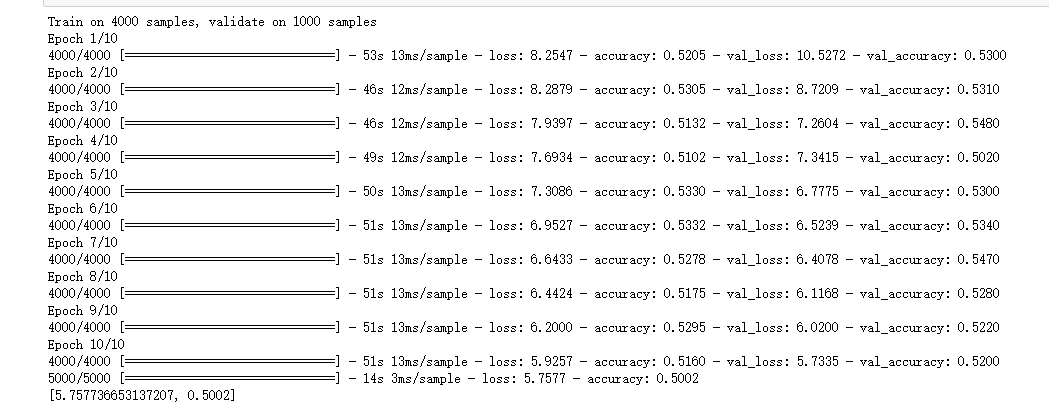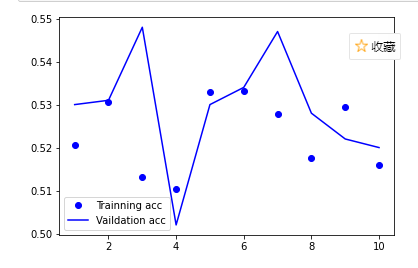人工智能作业2
# -*- coding: utf-8 -*- """ Neural Networks =============== Neural networks can be constructed using the ``torch.nn`` package. Now that you had a glimpse of ``autograd``, ``nn`` depends on ``autograd`` to define models and differentiate them. An ``nn.Module`` contains layers, and a method ``forward(input)``\ that returns the ``output``. For example, look at this network that classifies digit images: .. figure:: /_static/img/mnist.png :alt: convnet convnet It is a simple feed-forward network. It takes the input, feeds it through several layers one after the other, and then finally gives the output. A typical training procedure for a neural network is as follows: - Define the neural network that has some learnable parameters (or weights) - Iterate over a dataset of inputs - Process input through the network - Compute the loss (how far is the output from being correct) - Propagate gradients back into the network’s parameters - Update the weights of the network, typically using a simple update rule: ``weight = weight - learning_rate * gradient`` Define the network ------------------ Let’s define this network: """ import torch import torch.nn as nn import torch.nn.functional as F class Net(nn.Module): def __init__(self): super(Net, self).__init__() # 1 input image channel, 6 output channels, 5x5 square convolution # kernel self.conv1 = nn.Conv2d(1, 6, 5) self.conv2 = nn.Conv2d(6, 16, 5) # an affine operation: y = Wx + b self.fc1 = nn.Linear(16 * 5 * 5, 120) self.fc2 = nn.Linear(120, 84) self.fc3 = nn.Linear(84, 10) def forward(self, x): # Max pooling over a (2, 2) window x = F.max_pool2d(F.relu(self.conv1(x)), (2, 2)) # If the size is a square you can only specify a single number x = F.max_pool2d(F.relu(self.conv2(x)), 2) x = x.view(-1, self.num_flat_features(x)) x = F.relu(self.fc1(x)) x = F.relu(self.fc2(x)) x = self.fc3(x) return x def num_flat_features(self, x): size = x.size()[1:] # all dimensions except the batch dimension num_features = 1 for s in size: num_features *= s return num_features net = Net() print(net) ######################################################################## # You just have to define the ``forward`` function, and the ``backward`` # function (where gradients are computed) is automatically defined for you # using ``autograd``. # You can use any of the Tensor operations in the ``forward`` function. # # The learnable parameters of a model are returned by ``net.parameters()`` params = list(net.parameters()) print(len(params)) print(params[0].size()) # conv1's .weight ######################################################################## # Let try a random 32x32 input # Note: Expected input size to this net(LeNet) is 32x32. To use this net on # MNIST dataset, please resize the images from the dataset to 32x32. input = torch.randn(1, 1, 32, 32) out = net(input) print(out) ######################################################################## # Zero the gradient buffers of all parameters and backprops with random # gradients: net.zero_grad() out.backward(torch.randn(1, 10)) ######################################################################## # .. note:: # # ``torch.nn`` only supports mini-batches. The entire ``torch.nn`` # package only supports inputs that are a mini-batch of samples, and not # a single sample. # # For example, ``nn.Conv2d`` will take in a 4D Tensor of # ``nSamples x nChannels x Height x Width``. # # If you have a single sample, just use ``input.unsqueeze(0)`` to add # a fake batch dimension. # # Before proceeding further, let's recap all the classes you’ve seen so far. # # **Recap:** # - ``torch.Tensor`` - A *multi-dimensional array* with support for autograd # operations like ``backward()``. Also *holds the gradient* w.r.t. the # tensor. # - ``nn.Module`` - Neural network module. *Convenient way of # encapsulating parameters*, with helpers for moving them to GPU, # exporting, loading, etc. # - ``nn.Parameter`` - A kind of Tensor, that is *automatically # registered as a parameter when assigned as an attribute to a* # ``Module``. # - ``autograd.Function`` - Implements *forward and backward definitions # of an autograd operation*. Every ``Tensor`` operation, creates at # least a single ``Function`` node, that connects to functions that # created a ``Tensor`` and *encodes its history*. # # **At this point, we covered:** # - Defining a neural network # - Processing inputs and calling backward # # **Still Left:** # - Computing the loss # - Updating the weights of the network # # Loss Function # ------------- # A loss function takes the (output, target) pair of inputs, and computes a # value that estimates how far away the output is from the target. # # There are several different # `loss functions <https://pytorch.org/docs/nn.html#loss-functions>`_ under the # nn package . # A simple loss is: ``nn.MSELoss`` which computes the mean-squared error # between the input and the target. # # For example: output = net(input) target = torch.randn(10) # a dummy target, for example target = target.view(1, -1) # make it the same shape as output criterion = nn.MSELoss() loss = criterion(output, target) print(loss) ######################################################################## # Now, if you follow ``loss`` in the backward direction, using its # ``.grad_fn`` attribute, you will see a graph of computations that looks # like this: # # :: # # input -> conv2d -> relu -> maxpool2d -> conv2d -> relu -> maxpool2d # -> view -> linear -> relu -> linear -> relu -> linear # -> MSELoss # -> loss # # So, when we call ``loss.backward()``, the whole graph is differentiated # w.r.t. the loss, and all Tensors in the graph that has ``requires_grad=True`` # will have their ``.grad`` Tensor accumulated with the gradient. # # For illustration, let us follow a few steps backward: print(loss.grad_fn) # MSELoss print(loss.grad_fn.next_functions[0][0]) # Linear print(loss.grad_fn.next_functions[0][0].next_functions[0][0]) # ReLU ######################################################################## # Backprop # -------- # To backpropagate the error all we have to do is to ``loss.backward()``. # You need to clear the existing gradients though, else gradients will be # accumulated to existing gradients. # # # Now we shall call ``loss.backward()``, and have a look at conv1's bias # gradients before and after the backward. net.zero_grad() # zeroes the gradient buffers of all parameters print('conv1.bias.grad before backward') print(net.conv1.bias.grad) loss.backward() print('conv1.bias.grad after backward') print(net.conv1.bias.grad) ######################################################################## # Now, we have seen how to use loss functions. # # **Read Later:** # # The neural network package contains various modules and loss functions # that form the building blocks of deep neural networks. A full list with # documentation is `here <https://pytorch.org/docs/nn>`_. # # **The only thing left to learn is:** # # - Updating the weights of the network # # Update the weights # ------------------ # The simplest update rule used in practice is the Stochastic Gradient # Descent (SGD): # # ``weight = weight - learning_rate * gradient`` # # We can implement this using simple python code: # # .. code:: python # # learning_rate = 0.01 # for f in net.parameters(): # f.data.sub_(f.grad.data * learning_rate) # # However, as you use neural networks, you want to use various different # update rules such as SGD, Nesterov-SGD, Adam, RMSProp, etc. # To enable this, we built a small package: ``torch.optim`` that # implements all these methods. Using it is very simple: import torch.optim as optim # create your optimizer optimizer = optim.SGD(net.parameters(), lr=0.01) # in your training loop: optimizer.zero_grad() # zero the gradient buffers output = net(input) loss = criterion(output, target) loss.backward() optimizer.step() # Does the update ############################################################### # .. Note:: # # Observe how gradient buffers had to be manually set to zero using # ``optimizer.zero_grad()``. This is because gradients are accumulated # as explained in `Backprop`_ section.
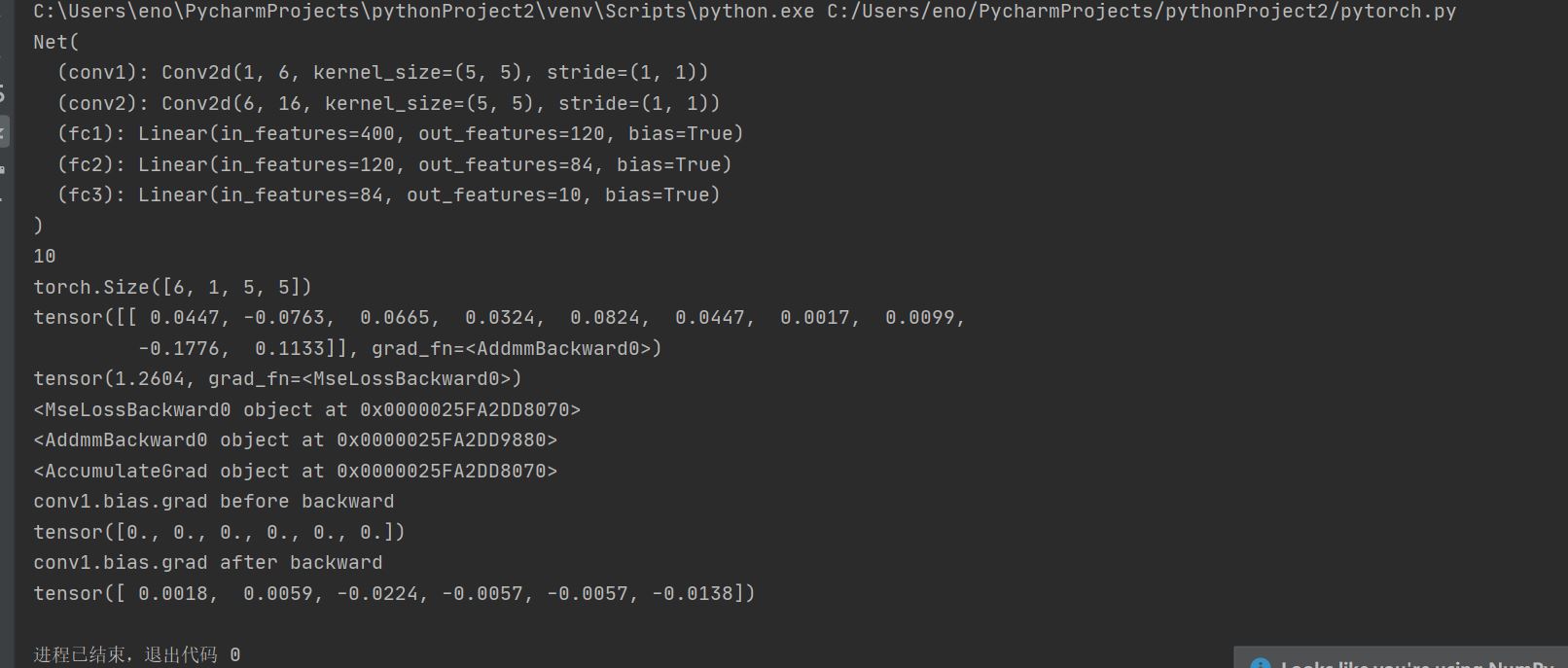
vgg代码
# 从keras.model中导入model模块,为函数api搭建网络做准备 from keras.models import Model from keras.layers import Flatten, Dense, Dropout, MaxPooling2D, Conv2D, BatchNormalization, Input, ZeroPadding2D, \ Concatenate from keras.layers.convolutional import AveragePooling2D from keras import regularizers # 正则化 from tensorflow.python.keras.optimizers import adam_v2 from tensorflow.python.keras.optimizers import rmsprop_v2 # 优化选择器 from keras.layers import AveragePooling2D from keras.datasets import mnist from keras.utils import np_utils import matplotlib.pyplot as plt import numpy as np # 数据处理 (X_train, Y_train), (X_test, Y_test) = mnist.load_data() X_test1 = X_test Y_test1 = Y_test X_train = X_train.reshape(-1, 28, 28, 1).astype("float32") / 255.0 X_test = X_test.reshape(-1, 28, 28, 1).astype("float32") / 255.0 Y_train = np_utils.to_categorical(Y_train, 10) Y_test = np_utils.to_categorical(Y_test, 10) print(X_train.shape) print(Y_train.shape) print(X_train.shape) def vgg16(): x_input = Input((28, 28, 1)) # 输入数据形状28*28*1 # Block 1 x = Conv2D(64, (3, 3), activation='relu', padding='same', name='block1_conv1')(x_input) x = Conv2D(64, (3, 3), activation='relu', padding='same', name='block1_conv2')(x) x = MaxPooling2D((2, 2), strides=(2, 2), name='block1_pool')(x) # Block 2 x = Conv2D(128, (3, 3), activation='relu', padding='same', name='block2_conv1')(x) x = Conv2D(128, (3, 3), activation='relu', padding='same', name='block2_conv2')(x) x = MaxPooling2D((2, 2), strides=(2, 2), name='block2_pool')(x) # Block 3 x = Conv2D(256, (3, 3), activation='relu', padding='same', name='block3_conv1')(x) x = Conv2D(256, (3, 3), activation='relu', padding='same', name='block3_conv2')(x) x = Conv2D(256, (3, 3), activation='relu', padding='same', name='block3_conv3')(x) x = MaxPooling2D((2, 2), strides=(2, 2), name='block3_pool')(x) # Block 4 x = Conv2D(512, (3, 3), activation='relu', padding='same', name='block4_conv1')(x) x = Conv2D(512, (3, 3), activation='relu', padding='same', name='block4_conv2')(x) x = Conv2D(512, (3, 3), activation='relu', padding='same', name='block4_conv3')(x) x = MaxPooling2D((2, 2), strides=(2, 2), name='block4_pool')(x) # Block 5 x = Conv2D(512, (3, 3), activation='relu', padding='same', name='block5_conv1')(x) x = Conv2D(512, (3, 3), activation='relu', padding='same', name='block5_conv2')(x) x = Conv2D(512, (3, 3), activation='relu', padding='same', name='block5_conv3')(x) # BLOCK 6 x = Flatten()(x) x = Dense(256, activation="relu")(x) x = Dropout(0.5)(x) x = Dense(256, activation="relu")(x) x = Dropout(0.5)(x) # 搭建最后一层,即输出层 x = Dense(10, activation="softmax")(x) # 调用MDOEL函数,定义该网络模型的输入层为X_input,输出层为x.即全连接层 model = Model(inputs=x_input, outputs=x) # 查看网络模型的摘要 model.summary() return model model = vgg16() optimizer = RMSprop(lr=1e-4) model.compile(loss="binary_crossentropy", optimizer=optimizer, metrics=["accuracy"]) # 训练加评估模型 n_epoch = 4 batch_size = 128 def run_model(): # 训练模型 training = model.fit( X_train, Y_train, batch_size=batch_size, epochs=n_epoch, validation_split=0.25, verbose=1 ) test = model.evaluate(X_train, Y_train, verbose=1) return training, test training, test = run_model() print("误差:", test[0]) print("准确率:", test[1]) def show_train(training_history, train, validation): plt.plot(training.history[train], linestyle="-", color="b") plt.plot(training.history[validation], linestyle="--", color="r") plt.title("training history") plt.xlabel("epoch") plt.ylabel("accuracy") plt.legend(["training", "validation"], loc="lower right") plt.show() show_train(training, "accuracy", "val_accuracy") def show_train1(training_history, train, validation): plt.plot(training.history[train], linestyle="-", color="b") plt.plot(training.history[validation], linestyle="--", color="r") plt.title("training history") plt.xlabel("epoch") plt.ylabel("loss") plt.legend(["training", "validation"], loc="upper right") plt.show() show_train1(training, "loss", "val_loss") prediction = model.predict(X_test) def image_show(image): fig = plt.gcf() # 获取当前图像 fig.set_size_inches(2, 2) # 改变图像大小 plt.imshow(image, cmap="binary") # 显示图像 plt.show() def result(i): image_show(X_test1[i]) print("真实值:", Y_test1[i]) print("预测值:", np.argmax(prediction[i])) result(0) result(1)
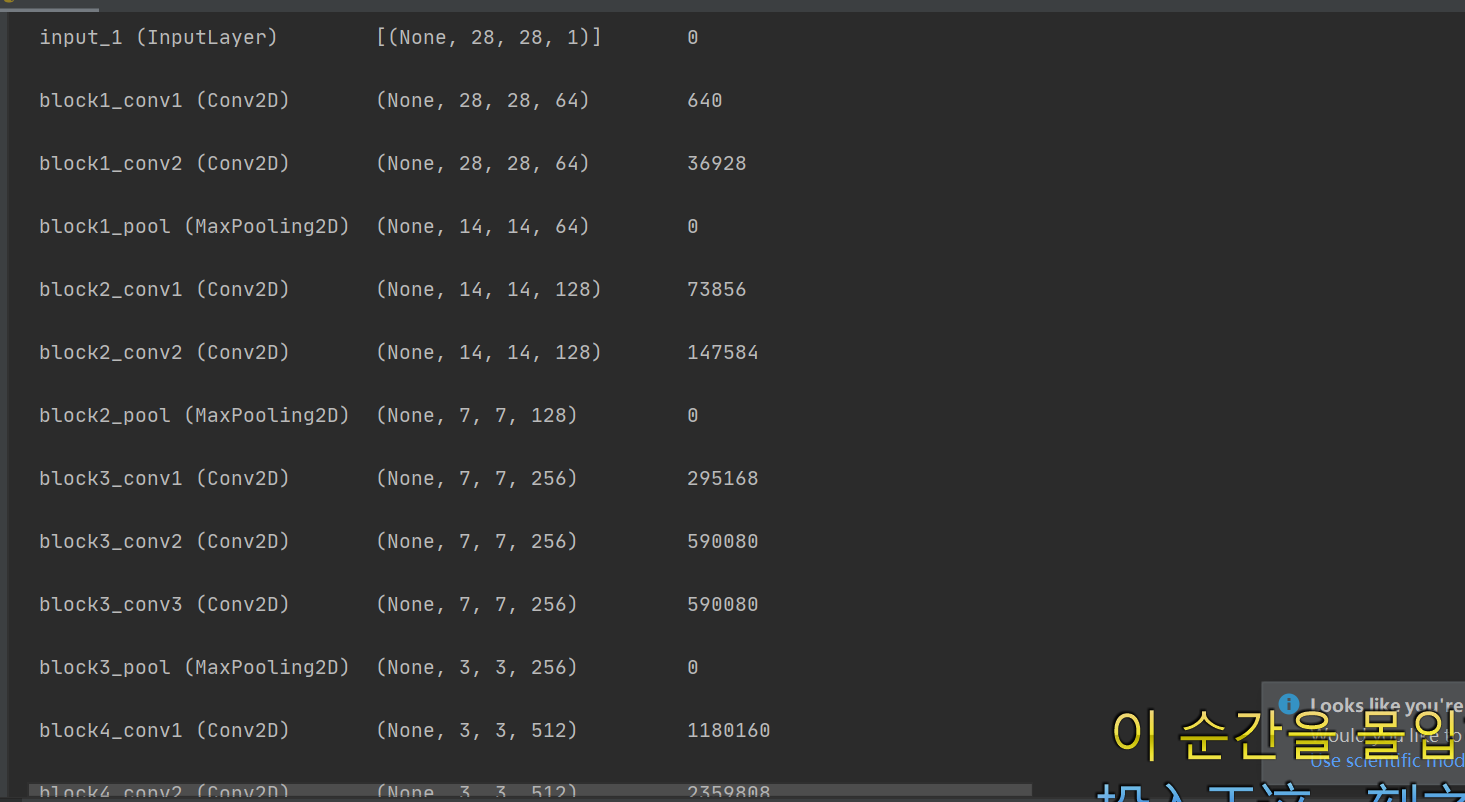
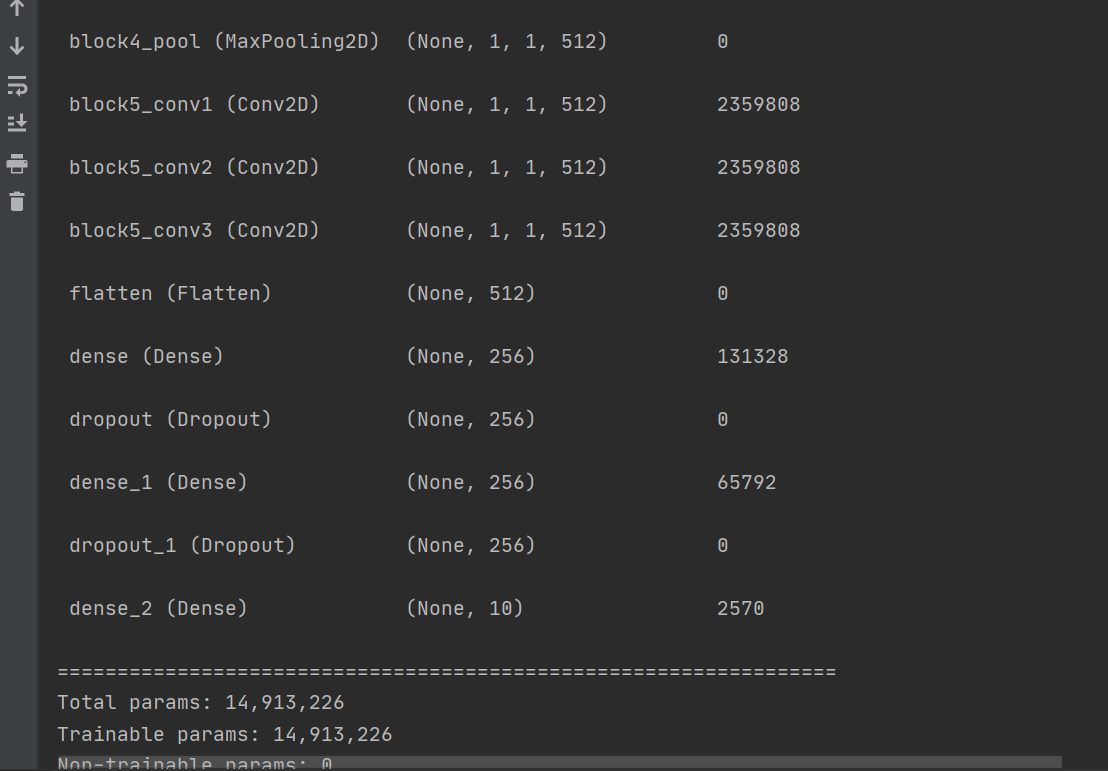
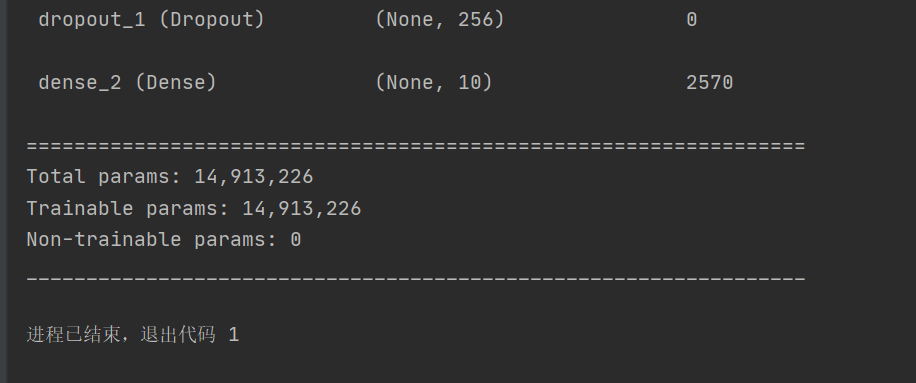
vgg课本上的代码
import tensorflow as tf from tensorflow import keras from tensorflow.keras import layers, regularizers import numpy as np import os import cv2 import matplotlib.pyplot as plt os.environ["CUDA_VISIBLE_DEVICES"] = "1" resize = 224 path =r"C:\train" def load_data(): imgs = os.listdir(path) num = len(imgs) train_data = np.empty((5000, resize, resize, 3), dtype="int32") train_label = np.empty((5000, ), dtype="int32") test_data = np.empty((5000, resize, resize, 3), dtype="int32") test_label = np.empty((5000, ), dtype="int32") for i in range(5000): if i % 2: train_data[i] = cv2.resize(cv2.imread(path+'/'+ 'dog.' + str(i) + '.jpg'), (resize, resize)) train_label[i] = 1 else: train_data[i] = cv2.resize(cv2.imread(path+'/' + 'cat.' + str(i) + '.jpg'), (resize, resize)) train_label[i] = 0 for i in range(5000, 10000): if i % 2: test_data[i-5000] = cv2.resize(cv2.imread(path+'/' + 'dog.' + str(i) + '.jpg'), (resize, resize)) test_label[i-5000] = 1 else: test_data[i-5000] = cv2.resize(cv2.imread(path+'/' + 'cat.' + str(i) + '.jpg'), (resize, resize)) test_label[i-5000] = 0 return train_data, train_label, test_data, test_label def vgg16(): weight_decay = 0.0005 nb_epoch = 100 batch_size = 32 # layer1 model = keras.Sequential() model.add(layers.Conv2D(64, (3, 3), padding='same', input_shape=(224, 224, 3), kernel_regularizer=regularizers.l2(weight_decay))) model.add(layers.Activation('relu')) model.add(layers.BatchNormalization()) model.add(layers.Dropout(0.3)) # layer2 model.add(layers.Conv2D(64, (3, 3), padding='same', kernel_regularizer=regularizers.l2(weight_decay))) model.add(layers.Activation('relu')) model.add(layers.BatchNormalization()) model.add(layers.MaxPooling2D(pool_size=(2, 2))) # layer3 model.add(layers.Conv2D(128, (3, 3), padding='same', kernel_regularizer=regularizers.l2(weight_decay))) model.add(layers.Activation('relu')) model.add(layers.BatchNormalization()) model.add(layers.Dropout(0.4)) # layer4 model.add(layers.Conv2D(128, (3, 3), padding='same', kernel_regularizer=regularizers.l2(weight_decay))) model.add(layers.Activation('relu')) model.add(layers.BatchNormalization()) model.add(layers.MaxPooling2D(pool_size=(2, 2))) # layer5 model.add(layers.Conv2D(256, (3, 3), padding='same', kernel_regularizer=regularizers.l2(weight_decay))) model.add(layers.Activation('relu')) model.add(layers.BatchNormalization()) model.add(layers.Dropout(0.4)) # layer6 model.add(layers.Conv2D(256, (3, 3), padding='same', kernel_regularizer=regularizers.l2(weight_decay))) model.add(layers.Activation('relu')) model.add(layers.BatchNormalization()) model.add(layers.Dropout(0.4)) # layer7 model.add(layers.Conv2D(256, (3, 3), padding='same', kernel_regularizer=regularizers.l2(weight_decay))) model.add(layers.Activation('relu')) model.add(layers.BatchNormalization()) model.add(layers.MaxPooling2D(pool_size=(2, 2))) # layer8 model.add(layers.Conv2D(512, (3, 3), padding='same', kernel_regularizer=regularizers.l2(weight_decay))) model.add(layers.Activation('relu')) model.add(layers.BatchNormalization()) model.add(layers.Dropout(0.4)) # layer9 model.add(layers.Conv2D(512, (3, 3), padding='same', kernel_regularizer=regularizers.l2(weight_decay))) model.add(layers.Activation('relu')) model.add(layers.BatchNormalization()) model.add(layers.Dropout(0.4)) # layer10 model.add(layers.Conv2D(512, (3, 3), padding='same', kernel_regularizer=regularizers.l2(weight_decay))) model.add(layers.Activation('relu')) model.add(layers.BatchNormalization()) model.add(layers.MaxPooling2D(pool_size=(2, 2))) # layer11 model.add(layers.Conv2D(512, (3, 3), padding='same', kernel_regularizer=regularizers.l2(weight_decay))) model.add(layers.Activation('relu')) model.add(layers.BatchNormalization()) model.add(layers.Dropout(0.4)) # layer12 model.add(layers.Conv2D(512, (3, 3), padding='same', kernel_regularizer=regularizers.l2(weight_decay))) model.add(layers.Activation('relu')) model.add(layers.BatchNormalization()) model.add(layers.Dropout(0.4)) # layer13 model.add(layers.Conv2D(512, (3, 3), padding='same', kernel_regularizer=regularizers.l2(weight_decay))) model.add(layers.Activation('relu')) model.add(layers.BatchNormalization()) model.add(layers.MaxPooling2D(pool_size=(2, 2))) model.add(layers.Dropout(0.5)) # layer14 model.add(layers.Flatten()) model.add(layers.Dense(512, kernel_regularizer=regularizers.l2(weight_decay))) model.add(layers.Activation('relu')) model.add(layers.BatchNormalization()) # layer15 model.add(layers.Dense(512, kernel_regularizer=regularizers.l2(weight_decay))) model.add(layers.Activation('relu')) model.add(layers.BatchNormalization()) # layer16 model.add(layers.Dropout(0.5)) model.add(layers.Dense(2)) model.add(layers.Activation('softmax')) return model #if __name__ == '__main__': train_data, train_label, test_data, test_label = load_data() train_data = train_data.astype('float32') test_data = test_data.astype('float32') train_label = keras.utils.to_categorical(train_label, 2) test_label = keras.utils.to_categorical(test_label, 2) #定义训练方法,超参数设置 model = vgg16() sgd = tf.keras.optimizers.SGD(lr=0.01, decay=1e-6, momentum=0.9, nesterov=True) #设置优化器为SGD model.compile(loss='categorical_crossentropy', optimizer=sgd, metrics=['accuracy']) history = model.fit(train_data, train_label, batch_size=20, epochs=10, validation_split=0.2, #把训练集中的五分之一作为验证集 shuffle=True) scores = model.evaluate(test_data,test_label,verbose=1) print(scores) model.save('model/vgg16dogcat.h5') acc = history.history['accuracy'] # 获取训练集准确性数据 val_acc = history.history['val_accuracy'] # 获取验证集准确性数据 loss = history.history['loss'] # 获取训练集错误值数据 val_loss = history.history['val_loss'] # 获取验证集错误值数据 epochs = range(1, len(acc) + 1) plt.plot(epochs, acc, 'bo', label='Trainning acc') # 以epochs为横坐标,以训练集准确性为纵坐标 plt.plot(epochs, val_acc, 'b', label='Vaildation acc') # 以epochs为横坐标,以验证集准确性为纵坐标 plt.legend() # 绘制图例,即标明图中的线段代表何种含义 plt.show()
